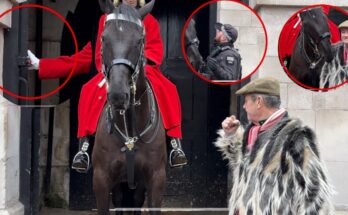Have you ever noticed how horses constantly move their ears — forward, back, twitching, or rotating like little radars?
In this video, we zoom in on a beautiful ceremonial horse at London’s Horse Guards Parade. While standing nearly motionless in front of the crowd, its ears are doing something incredible — communicating silently. You may not hear it, but the horse is “speaking” loud and clear… to its rider, the crowd, the environment, and even other horses nearby.
So, why do horses move their ears like that?
Unlike humans, horses use their ears as one of their primary tools for expression and awareness. Here’s what those movements mean:
👂 Forward Ears
Ears pointing forward show interest, curiosity, or alertness. In the Guard, that might mean the horse is listening to nearby footsteps or a tourist trying to take a photo.
👂 Backward Ears (Not pinned flat!)
Slightly backward ears can simply mean the horse is listening to the rider’s commands or tuning in to what’s behind it. It doesn’t always mean aggression — especially in trained ceremonial horses.
👂 Constant Flicking or Rotating
When ears flick in multiple directions, it shows the horse is processing multiple stimuli at once. In a busy place like Whitehall, this means the horse is staying sharp — aware of traffic, voices, and commands all at once.
👂 Pinned Back Flat
Now this is the warning sign. Flat, tight ears often indicate annoyance, stress, or potential aggression. It’s the horse’s way of saying: “Back off.” But in this video, our calm royal horse handles the crowd with grace — flicking its ears, but never showing signs of distress.
These subtle ear movements are part of a much larger equine language — one that experienced handlers, riders, and even the guards learn to read fluently. It’s how the guards can stand for hours, trusting their horse to alert them to changes, danger, or discomfort without ever needing a word.
So the next time you see a horse — whether in the wild, on a farm, or in a royal parade — pay close attention to its ears. You might be witnessing an entire conversation… without a single sound.



